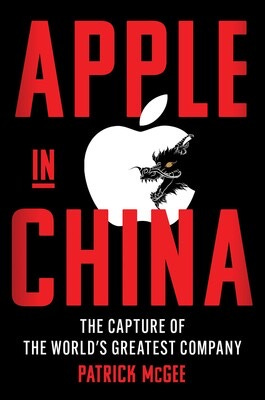Think different
Review of Apple in China: the capture of the world's greatest company by Patrick McGee. Scriber, 2025.
"Designed by Apple in California. Assembled in China." These words that have adorned iPods and iPhones seemingly capture the essence of outsourcing: washing ones' hands of the tangible making of things to focus on the higher value-added activities of designing and branding them. But in Apple's case, that view would be quite wrong. Patrick McGee, formerly the Financial Times' lead Apple correspondent, has written a compelling history of the industrial, product, and manufacturing design and operational excellence that has delivered some of the most beloved consumer devices of all time. But he mars that history by overstating the extent to which Apple's dependence on China that has left it "captured."
Apple is more than a design house and fanatical manager of supplier cost and quality. Indeed, like no other firm, the company has embedded its engineers in factories across China and spent billions on equipment for its partners to execute its sophisticated designs. Manufacturing partners have willingly accepted punishing margins to work with Apple because what they learn by working with the company ultimately makes them more competitive and profitable serving other clients.
Apple's sophisticated approach to China as a production hub has been matched only by the naivete of its understanding of China as a market for its products and geopolitical force. Executives flew in and out of China with abandon, but only scarcely understood it. For years, Apple underestimated demand for the iPhone in China, allowing an underpowered distribution network to be exploited by scalpers. The company was blindsided in 2013 when it began to be subjected to intensifying political scrutiny. China's leaders, who wanted Apple to conform to the traditional joint venture model of knowledge transfer, failed to appreciate the far more valuable role the company was playing in continuously upleveling the country's manufacturing sector. When Apple executives realized this, they shed their usual aversion to political engagement to quantify their value, establishing in-country R&D centers as a further symbol of its commitment.
Apple would also be called upon to comply with Beijing's growing censorship and data demands, resulting in the removal of the New York Times and VPN services from its app stores and the localization of China users' data. Apple also abruptly stopped some of its labor standards reporting amid a government crack down on labor activism. While discordant with the firm's expressed values, McGee does not mischaracterize these developments as moral failures on Apple's part nor suggest that it would have somehow approached them differently if it didn't rely as extensively on China. Apart from an internal dictate that Apple's streaming service not commission shows that portray China in an excessively negative light, McGee does not suggest that Apple has been instrumentalized to advance Beijing's geopolitical objectives.
Far more consequential than government intervention has been the intensifying onshore competition that has made Apple's China business increasingly tenuous. Indeed, as early as the iPhone XR, Apple sales in China began to lose momentum as Huawei's surged. The Trump administration's sanctions on Huawei granted Apple a temporary reprieve, but the Shenzhen-based company has recovered. Apple's rival now controls its own operating system poised to rival iOS and Android as a global standard. What's striking is the extent to which Apple accelerated the emergence of its own competitors. It is a recurring pattern of outsourcing partners turning rivals under their own brand. Apple's effect was different. Concerned about suppliers becoming overly dependent on the company only for Apple to change directions and bankrupt them, Apple instituted a rule that it never account for more than half of a supplier's business. By forcing suppliers to grow as fast as Apple with another partner, "Apple gave birth to the Chinese smartphone industry."
Apple faces significant challenges, including a stagnant product portfolio and a troubled AI strategy. But McGee may overstate the challenge of its dependence on China. Whereas so many firms that outsource ultimately lose their understanding of their supply chain and how to make their own products, it is Apple's refusal to do so that positions it better than almost any other firm now moving to diversify away from China to countries including India and Vietnam. Even as it does so, it is mitigating Beijing's concerns by shifting the mix of suppliers in China to be more "red," or Chinese-owned, after years of reliance on Taiwan's Foxconn.
McGee writes of an intent to neither “condemn Cook or Apple. It's to convey the predicament they're in ... Cook shouldn't be blamed by politicians for enmeshing Apple's operations in China two decades ago, but he has erred by doubling down over the past decade despite mounting evidence that Xi has been ramping up repression at home and taking a more combative stance in international affairs." But, as McGee concedes by quoting a source: "You can say that we read them wrong, that we misunderstood China. But Jack Ma read China wrong, too. Every entrepreneur read China wrong." That's one framing. But to read this book is to appreciate all the things that Apple - and China's own entrepreneurs - have and continue to get right to the delight of consumers the world over. And in retelling Apple's first forays to Tokyo, Taiwan, and South Korea, it is also a reminder that the history of outsourcing predates China and will continue beyond it.


